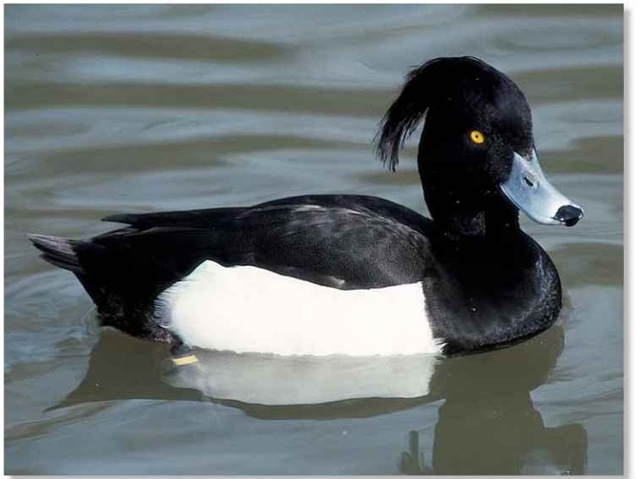ORDER
Anseriformes
FAMILY
Anatidae
GENUS & SPECIES
KEY FEATURES
• Common and widespread species as a result of a huge expansion that began only 150 years ago
• Dives for food in lakes, but is tame enough to take bread from humans in parks
. • Named after its “ponytail” of feathers, its local name of magpie diver is equally descriptive
WHERE IN THE WORLD?
Occupies broad range from Iceland across western and northern Europe, through Siberia to Japan; winters in Africa and southeastern Asia
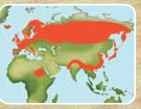
LIFECYCLE
Sociable and bold on park lakes, the tufted duck has taken full advantage of natural and man-made habitats to become one of Britain’s most successful wildfowl species.
HABITAT
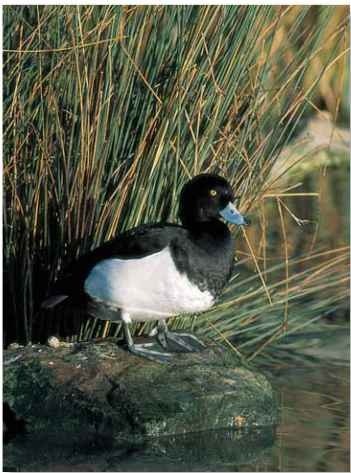
A Ready made Shallow ponds provide all life’s necessities.
Chiefly a bird of freshwater habitats, the tufted duck does overwinter in sheltered estuaries and coastal bays. For
the rest of the year, it favors lowland lakes and slow rivers.
Swift adaptation to new habitats is the key to the tufted duck’s phenomenal recent success. It was one of the first species to take advantage of the many new habitats created in the 20th century through the flooding of gravel pits and the construction of reservoirs and ornamental ponds.
CONSERVATION
The tufted duck has expanded its range and population throughout Europe this century. Since it first bred in Britain in 1849, during a period of climatic warming, its spread has been helped by the increasing number of reservoirs and gravel pits, and by the abundance of the introduced zebra mussel.The tufted duck now has a permanent British population of about 18,000 breeding adults, while the number of overwintering birds is thought to exceed 90,000.
BREEDING
Communal courtship begins as soon as the male has acquired his new plumage in late autumn, but pair bonds are often formed in spring.
In winter, males display in groups. They become highly vocal, whistling as they swim back and forth, tossing and shaking their heads. Females will respond by growling, stretching their necks and ritually preening their wings.
Small islands are favored breeding sites; on some of them, there may be hundreds of nests spaced about 15′ apartThe male plays no part in egg incubation or care of the young. Ducklings learn to dive within a few hours of hatching, but at first they feed mainly on surface insects.
FOOD & FEEDING
The tufted duck’s principal prey is the zebra mussel, but it also takes other freshwater mollusks, shrimp, caddisfly and dragonfly larvae, water beetles and a few small fish. When it winters in coastal waters, marine mussels and cockles form the bulk of its diet. It also eats aquatic vegetation. The duck feeds by diving to depths of up to 46′ and dabbling in the muddy or sandy bottom.
Up for a breather A duck may make up to 100 dives in an hour.
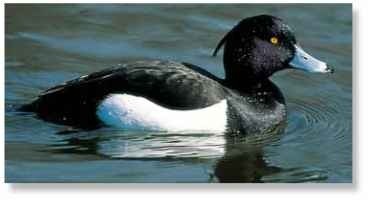
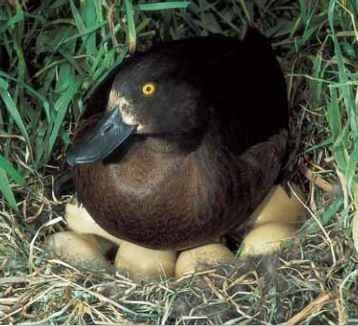
A Eggs-treme
One nest contained 22 eggs — probably the work of two females.
Females have adopted lost or deserted ducklings.
The largest colonies of breeding tufted duck in the British Isles are on Lough Neagh in northern Ireland and Loch Leven in Scotland.
The average life expectancy of an adult tufted duck is only about 19 months.
Feeding dives lasting 40 seconds have been recorded, although most last about 15.
HAZARDOUS JOURNEY
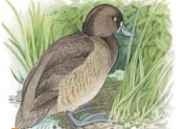
Nesting…
A female builds her nest among thick reeds near the edge of a lake. She lays in mid- to late May.
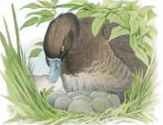
Incubating…
Camouflaged by dull, brown plumage she incubates her clutch hidden from egg thieves.
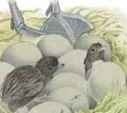
Hatching…
The ducklings hatch three and a half weeks later, just in time for the early-summer glut of insects.

Leading
However, few ducklings escape the predators, such as gulls, that lurk around every corner.
BEHAVIOR
The tufted duck may form flocks many thousands strong, although groups of 50 or so are more common. Outside the breeding season, flocks are often predominantly or wholly one sex, since males leave nesting areas ahead of females. Males gather in groups as they make the transition into dull eclipse plumage, a molt that begins in late May and includes 3-4 weeks during which they are flightless.
The tufted duck roosts at night, usually in a lake where it is safe from predators such as the fox and the weasel. Most populations in Britain do not migrate, but many birds from northern Europe winter on British lakes and rivers.
Safety in numbers The tufted duck roosts in a tight bunch.
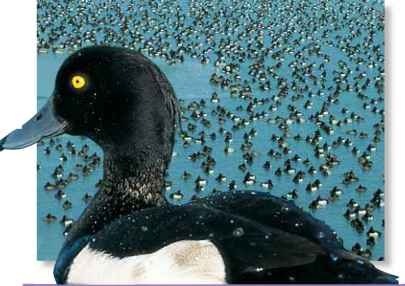
PROFILE
Tufted Duck
The flamboyant crest and striking coloring of the male duck make it one of the most easily recognized birds, but they are not permanent features.
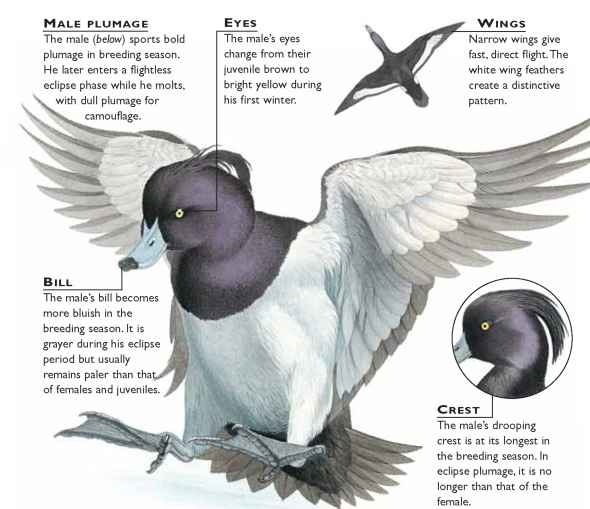
CREATURE COMPARISONS
The scaup (Aythya marila) looks similar to the tufted duck, but it is around 10% larger and lacks a crest.The scaup winters on some of the same British waters and is commonly seen in winter off the east coast of the U.S.; the tufted duck prefers freshwater. Both dive and dabble beneath the surface to feed.They are hardest to distinguish when tufted duck males are in eclipse plumage and their crest is diminished. Hybrids of the two species are not uncommon.
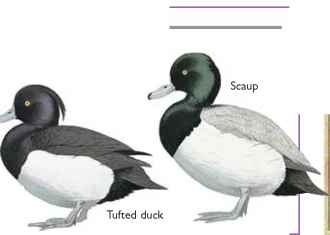
| VITAL | |
| STATISTICS | |
| Weight | Male 2-2.5 lbs.; female 1.8-2 lbs. |
| Length | 16-19″ |
| Wingspan | 27-30″ |
| Sexual Maturity | 1-2 years |
| Breeding Season | May-August |
| Number of Eggs | 8-11 |
| .. Incubation Period | 23-28 days |
| Fledging Period | 45-50 days |
| Breeding Interval | 2 clutches a year in south; otherwise 1 year |
| Typical Diet | Crustaceans, insects, plants |
| Lifespan | Up to 14 yrs. |
RELATED SPECIES
• Hybridization sometimes occurs 1 between the 12 related species in the genus Aythya, which includes: the tufted duck; the ring-necked duck, A. collaris; the white-eyed duck, A. australis,an Australian species; the ferruginous duck, A. nyroca; and the pochard, A. ferina — a chestnut-headed duck often found with the tufted duck on British lakes and ponds.
